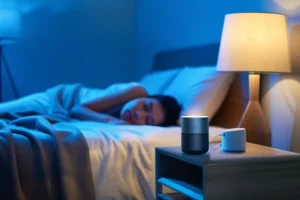Exploring the possibility of a sleep apnea test at home can be a significant first step towards better health and improved sleep quality. With advancements in technology, individuals now have the convenience of diagnosing sleep apnea from the comfort of their own home. This method not only provides ease and privacy but also accelerates the initial diagnosis process. Home testing kits typically include devices that monitor various physiological parameters during sleep, such as breathing patterns, oxygen levels, and heart rate. Understanding how these tests work, their accuracy, and how they compare to traditional in-lab sleep studies can empower you to take proactive steps in managing your sleep health effectively.
Why Choose a Home Sleep Apnea Test?
Sleep apnea is a serious condition that affects millions of people worldwide. Traditional sleep studies often require an overnight stay in a medical facility, which can be inconvenient and uncomfortable. Fortunately, modern advancements have made it possible for patients to perform sleep apnea tests in the comfort of their own homes. This article explores why choosing a home sleep apnea test can be a beneficial option for many individuals.
One of the main advantages of home sleep apnea tests is their convenience and comfort. Many people find it difficult to sleep in a strange environment, which can affect the accuracy of the test. Home tests allow you to sleep in your own bed, resulting in more natural sleep patterns. Additionally, home tests are often less intrusive, involving fewer wires and sensors compared to traditional in-lab studies.
Another reason to consider a home sleep apnea test is its cost-effectiveness. Traditional sleep studies can be quite expensive, often involving costs for the overnight stay, the use of specialized equipment, and the analysis of results by trained professionals. Home tests typically come at a fraction of the cost, making them a more affordable option for many individuals.
Convenience and Comfort
When it comes to diagnosing sleep apnea, convenience and comfort are crucial factors. Traditional in-lab sleep studies require you to spend the night in a sleep clinic, which can be an uncomfortable experience due to the unfamiliar environment and the presence of multiple monitoring devices. This can disrupt your sleep, potentially leading to results that don’t accurately reflect your typical sleep patterns. Home sleep apnea tests, on the other hand, allow you to undergo the test in your own bed. You can follow your usual bedtime routine, which helps to ensure that the results are more representative of your regular sleeping habits. This leads to more accurate and reliable data, which is essential for making an accurate diagnosis and developing an effective treatment plan.
In addition to the comfort of being in your own home, home sleep apnea tests are generally less invasive. The devices used for home testing are usually smaller and require fewer sensors, making them easier to use and less disruptive to your sleep. This increases the likelihood of obtaining high-quality data without the stress and discomfort of traditional sleep studies.
Cost-Effectiveness
The cost of diagnosing and treating sleep apnea can be significant, especially when you factor in the expenses associated with traditional in-lab sleep studies. These costs can include fees for the overnight stay, the use of specialized diagnostic equipment, and the interpretation of the results by trained professionals. For many people, these expenses can be a barrier to seeking diagnosis and treatment.
Home sleep apnea tests offer a much more cost-effective alternative. Because they eliminate the need for an overnight stay in a medical facility, the overall cost is significantly reduced. The testing equipment for home use is also more affordable, and the results can often be interpreted by your physician, further reducing the expense.
Several studies have shown that home sleep apnea tests are not only more affordable but also equally effective in diagnosing sleep apnea as traditional in-lab studies. This makes them an attractive option for individuals who are concerned about the financial burden of testing and treatment.
Quick Results
One of the frustrations of traditional sleep studies is the time it can take to receive your results. After spending a night in a sleep clinic, it may take several days or even weeks to get the analysis and diagnosis from the sleep specialist. This delay can be stressful, especially if you are experiencing significant symptoms and are eager to start treatment.
Home sleep apnea tests offer the advantage of providing quicker results. Because the data can often be uploaded electronically and analyzed promptly, many patients receive their diagnosis within a much shorter timeframe. This means you can begin treatment sooner, improving your overall health and quality of life more quickly.
In addition to faster results, the streamlined process of home sleep apnea tests reduces the need for multiple appointments and follow-ups, saving you time and hassle. This efficiency is particularly beneficial for individuals with busy schedules or those who live far from a sleep clinic.
Overall, the convenience, cost-effectiveness, and quick results of home sleep apnea tests make them an excellent option for many individuals. If you suspect that you may have sleep apnea, talk to your doctor about whether a home sleep apnea test might be right for you. By exploring more articles on this topic, you can gain a deeper understanding of sleep apnea and the various diagnostic and treatment options available to you.
How Does a Home Sleep Apnea Test Work?
Home sleep apnea tests (HSATs) have revolutionized the way we diagnose sleep disorders. Unlike traditional in-lab polysomnography, these tests allow patients to monitor their sleep in the comfort of their own bed. This approach not only enhances patient comfort but also provides an accurate representation of their typical sleep patterns.
The goal of an HSAT is to collect data on your breathing, oxygen levels, and other physiological parameters while you sleep. The data collected is then analyzed to determine if you have sleep apnea and how severe it may be. Studies have shown that HSATs are highly effective in diagnosing sleep apnea, with sensitivity and specificity rates comparable to those of in-lab tests.
The convenience and reliability of HSATs make them an increasingly popular choice for both patients and healthcare providers. By understanding the process, equipment, and instructions for use, you can confidently perform a home sleep apnea test and take the first step towards better sleep health.
Understanding the Process
The process of undergoing a home sleep apnea test is straightforward and designed to be user-friendly. First, your healthcare provider will assess whether an HSAT is appropriate for you based on your symptoms and medical history. If deemed suitable, you’ll receive a home sleep test kit along with detailed instructions on how to use it.
During the night of the test, you’ll set up the equipment according to the guidelines provided. Most HSATs involve attaching sensors to specific parts of your body, such as your chest, finger, and nasal area. These sensors will monitor various parameters, including airflow, blood oxygen levels, and respiratory effort, while you sleep.
The entire process typically takes just one night. Once the test is complete, you return the equipment to your healthcare provider or the testing facility. The collected data will then be analyzed by a sleep specialist to determine if you have sleep apnea and to what extent it affects your sleep quality and overall health.
What Equipment is Needed?
Home sleep apnea tests require a few essential pieces of equipment to accurately monitor your sleep. The typical HSAT kit includes the following components:
- Breathing Sensors: These are usually attached near your nose and mouth to measure airflow during sleep.
- Oximeter Probe: This small device is placed on your finger to monitor blood oxygen levels throughout the night.
- Chest Belt: This belt is wrapped around your chest to measure respiratory effort and detect any interruptions in breathing.
- Data Recorder: Connected to the sensors, the recorder stores all the collected data for later analysis.
This equipment is designed to be minimally intrusive, allowing you to sleep comfortably while still capturing the necessary data. Advances in technology have also made these devices more compact and easier to set up compared to earlier models, further simplifying the testing process.
Ensuring the equipment is properly set up is crucial for obtaining accurate results. Follow the instructions provided by your healthcare provider closely to make sure each component is positioned correctly. If you experience any difficulties, many providers offer support services to assist you in setting up the equipment properly.
Instructions for Use
Using a home sleep apnea test kit is simpler than it may initially seem. Here are some general guidelines to help you through the process:
- Read all instructions thoroughly before beginning the test. Familiarize yourself with each piece of equipment and its function.
- On the night of the test, refrain from consuming alcohol or caffeine, as these substances can affect your sleep patterns and potentially skew the results.
- Set up the equipment as instructed. Attach the breathing sensors, oximeter probe, and chest belt to their designated positions. Ensure that each sensor is securely fastened but not too tight to avoid discomfort.
- Once everything is set up, try to maintain your usual sleep routine. The goal is to collect data that accurately reflects your typical sleep habits.
After you wake up, carefully remove the equipment and store it in the provided case. Return the kit to your healthcare provider or the designated testing facility. The data will then be analyzed, and you will receive a report detailing the findings, which will include recommendations for any necessary treatment or further testing.
For more comprehensive insights into sleep health and related topics, be sure to explore our other informative articles. Your journey to better sleep and overall health starts with staying informed!
Comparing Home Tests vs. Lab Tests
In recent years, the availability of home testing kits has surged, offering a convenient alternative to traditional lab tests. However, it’s crucial to understand the differences between these two methods to make an informed decision. This article delves into the comparison of home tests and lab tests, focusing on accuracy, reliability, and the pros and cons of each method.
While home tests provide the advantage of convenience and privacy, lab tests are often considered the gold standard in medical diagnostics. Understanding the intricacies of each can help you determine which is more suitable for your specific needs.
Accuracy and Reliability
The accuracy and reliability of a test largely depend on the technology and protocols used during the testing process. Home tests are designed to be user-friendly, but this simplicity can sometimes compromise the precision of the results. Despite advancements, many home tests may not match the stringent quality controls employed in lab settings.
Laboratory tests are conducted by trained professionals and undergo rigorous quality checks. This ensures a higher level of accuracy and reliability. Studies have consistently shown that lab tests minimize the risk of false positives and false negatives, making them more dependable for critical diagnosis.
A 2020 study published in the Journal of Medical Internet Research found that while home testing kits for various conditions have improved significantly, they still lag behind lab tests in terms of consistency and reliability. Home tests may offer quicker results, but the trade-off often lies in the accuracy of those results.
Moreover, lab tests benefit from advanced diagnostic equipment and the ability to conduct comprehensive analyses. These capabilities allow for a more accurate diagnosis, especially in complex cases where multiple tests are required for confirmation.
Pros and Cons
Each testing method has its own set of advantages and disadvantages that can influence your choice. Let’s break them down:
- Home Tests:
- Pros:
- Convenience: Tests can be taken in the comfort of your own home.
- Privacy: No need to visit a clinic or interact with medical personnel.
- Speed: Results are often available more quickly.
- Cons:
- Accuracy: Potential for user error and less stringent quality controls.
- Reliability: May have a higher rate of false positives or negatives.
- Comprehensiveness: Limited scope compared to lab tests.
- Lab Tests:
- Pros:
- Accuracy: High precision and low error margins.
- Reliability: Conducted by professionals with rigorous quality controls.
- Comprehensiveness: Ability to perform a wide range of diagnostic tests.
- Cons:
- Convenience: Requires a visit to a medical facility.
- Cost: Can be more expensive than home testing kits.
- Time: Results may take longer to process.
Ultimately, the choice between home tests and lab tests will depend on your specific situation and needs. If you’re seeking quick, convenient results for a non-critical issue, a home test might suffice. However, for more accurate and reliable results, especially for serious health concerns, lab tests remain the preferred option.
Interested in learning more about health diagnostics? Check out our other articles to stay informed about the latest advancements and trends in medical testing.
What to Expect After the Test
After undergoing an implantology and bone regeneration procedure, it is important to understand what to expect during the recovery phase. This knowledge can help you manage your expectations and take appropriate steps to ensure optimal healing and successful results.
The recovery process can vary among patients, but typically, you can expect some common post-procedure experiences. These may include minor swelling, discomfort, and sensitivity around the affected area. Your dentist will provide you with specific aftercare instructions to manage these symptoms effectively.
It’s crucial to follow your dentist’s guidelines for post-operative care, which often include recommendations for pain management, diet, and oral hygiene. Adhering to these guidelines can significantly impact the success rate of your implant and bone regeneration treatment.
Getting Your Results
After your procedure, your dentist will schedule a follow-up appointment to evaluate the success of the implant and bone regeneration. This typically involves a thorough examination and, in some cases, imaging tests such as X-rays to assess the integration of the implant with the bone.
Your dentist will discuss the preliminary results with you and address any immediate concerns or questions you may have. It is a good opportunity to clarify aspects of the recovery process and understand what the next steps will be.
Remember, the healing process can vary, and it may take several months for the implant to fully integrate with the bone. Patience is essential, and regular follow-up visits are crucial to monitor progress and make any necessary adjustments to your treatment plan.
Next Steps
Based on the initial results and examination, your dentist will outline the next steps in your treatment plan. This may include additional follow-up visits, adjustments to your oral hygiene routine, or further procedures if necessary. It’s essential to maintain open communication with your dentist throughout the recovery period. Report any unusual symptoms or concerns promptly to ensure any potential issues are addressed quickly.
In most cases, successful bone regeneration and implant integration can lead to long-term benefits, including improved oral function and aesthetics. Following your dentist’s advice and maintaining a healthy lifestyle can significantly contribute to the longevity of your implants.
For more information on implantology and bone regeneration, and to stay informed about the latest advancements in dental care, be sure to explore our other insightful articles. Your journey to a healthier and brighter smile starts here!
Frequently Asked Questions about At-Home Sleep Apnea Testing
If you’re considering taking a sleep apnea test at home, you probably have some questions. Here’s a quick guide to help you understand the process and what to expect.
What equipment is used for a sleep apnea test at home?
Home sleep apnea tests generally involve using a portable monitoring device that you can set up yourself. This device typically records your airflow, heart rate, blood oxygen levels, and breathing patterns while you sleep. The simplicity of the setup enables you to comfortably sleep in your own bed while the test is conducted, ensuring the results reflect your natural sleep behaviors.

My name is Salman Kapa, a 73-year-old expert in bone regeneration and dental implantology. With decades of experience in the field, I am dedicated to advancing our understanding of oral health and hygiene. Through my research and writing, I aim to contribute to the development of innovative solutions in dental care.




